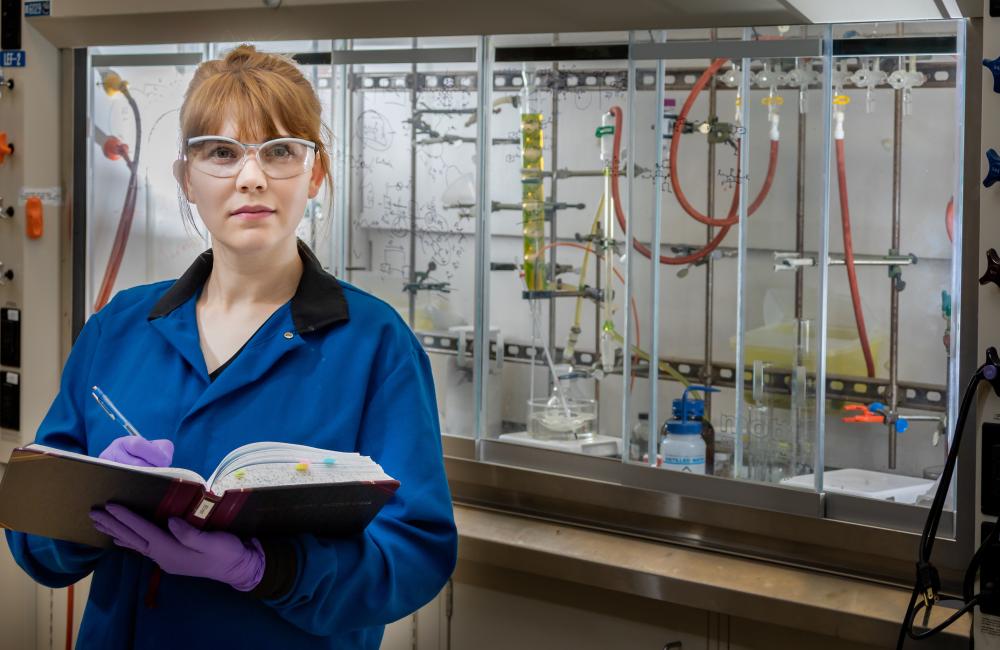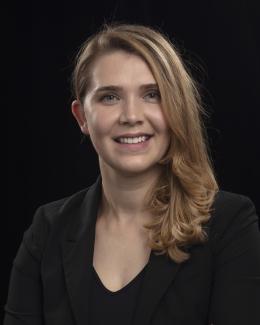Organic chemist Santa Jansone-Popova designs new chemical architectures to support chemical separations that lay the groundwork for clean water and energy advances. Credit: Carlos Jones/Oak Ridge National Laboratory, U.S. Dept. of Energy.
An organic chemist at Oak Ridge National Laboratory, Santa Jansone-Popova focuses on the fundamental challenges of chemical separations that translate to world-changing solutions for clean water and sustainable energy. For Jansone-Popova purpose is a strong motivator, but so is art. Real-world opportunities develop from basic research to design novel chemical architectures, she says. “To push what is possible, we will need to create structures that have never been made before.”
Art and science
As a teenager in Latvia, Jansone-Popova craved a narrative of possibility. She excelled at chemistry in high school and could easily imagine a path leading to university and professional opportunities as a scientist, but she wanted to keep her options open. At heart, she was free-spirited and passionate about a lot of things. “There are so many possible futures,” she said. “Who knows what you want to do forever when you are young?”
She kept a running list of potential subject areas she would select for the centralized exams required for college admissions in Latvia—math, German, science, and art—eventually settling on chemistry and design. She was confident enough to sit for the 3-hour design exam without ever having taken a single art class. Her “perfectly adequate” illustration may have scored poorly, but she aced the chemistry exam.
In college, Jansone-Popova was drawn in by the art and science of “total synthesis,” a reverse-engineering approach to developing new, complex chemical structures. A synthetic organic chemist looks at compounds in nature and tries to break apart intricate structures into smaller pieces and then reassemble everything, she explained. “It’s like solving a puzzle,” she said, something she knew would fascinate her forever.
While completing undergraduate studies at the University of Latvia, Jansone-Popova worked at the Latvian Institute of Organic Synthesis, gaining hands-on lab experience in the craft of making organic compounds. The job positioned her well for graduate studies at the University of Houston, where she continued to explore total synthesis and developed new methods for creating multi-ringed carbon structures known as polycycles.
After earning a Ph.D. in 2014, Jansone-Popova joined ORNL’s Chemical Separations group, where her background in organic synthesis has been an asset to the fundamental work of separating and extracting elements, especially metals. The bridge from understanding how metal ions behave to creating new materials to recover valuable elements or remove contaminants from the environment starts with fundamental discoveries that lead to new ways of thinking and problem-solving.
Problems in solution
Jansone-Popova’s early research at the lab focused on small-molecule synthesis. Supported by the Department of Energy’s Office of Science, she made ligands, or metal-binding molecules, that self-assemble to form complex structures, such as triple-stranded helixes. The work has since expanded to larger molecular networks, like polymers, which chain together many small molecules. An important application of the basic research is to make polymers that efficiently select chromium. Hexavalent chromium—prominent as a health risk in the movie Erin Brockovich—is an extremely toxic industrial pollutant in waste streams that can end up in the environment. “There are commercially available resins to remove chromium, but our basic-to-applied goal is to improve the efficiency of adsorbents,” said Jansone-Popova. “To do that, you need a material that is highly selective, meaning it can pick out chromium among all of the other elements present.”
One of the challenges of creating materials that can select chromium in industrial waste, uranium in seawater, radioactive metals in nuclear fuel, or carbon dioxide in gas emissions is that there are competing elements in these solutions that can impact the efficiency of your approach. How do you get chromium but not sulfur, arsenic or selenium, which are also contaminants in water?
“Fundamental research is what allows us to answer these kinds of questions and move forward,” said Jansone-Popova. “The real-world value of fine-tuning selectivity and efficiency is that you enable materials that work faster, cost less and offer realistic options for widespread uses.”
Endless possibility
Fully artist and chemist, Jansone-Popova designs with molecules to achieve new chemical structures that underlie endless possibilities in separation science. Translating fundamental research to support additional energy missions is an important outgrowth of the work.
Some of the most promising energy advances, such as CO2 capture, critical material recovery and desalination, are all dependent on chemical separations.
Jansone-Popova’s research plays a key role in the Critical Materials Institute—a DOE Energy Innovation Hub funded by the Advanced Manufacturing Office of the Office of Energy Efficiency and Renewable Energy—in strategies to recover rare earth elements and other critical materials used in clean energy technologies, including wind and solar power, electric vehicles and energy-efficient lighting. Through the CMI, Jansone-Popova collaborates on efficient lanthanide separations. The majority of rare earths are lanthanides, a group of 15 metallic elements grouped near the bottom of the periodic table with the actinides. “When you mine rare earths, they are naturally lumped together in ore, so separating one from the mixture is challenging,” said Jansone-Popova. Her team recently demonstrated a praseodymium-neodymium separation strategy with unprecedented potential.
Jansone-Popova also contributes new insights to the lab’s decades of expertise in lanthanide and actinide separations related to the nuclear fuel cycle. Supported by the Office of Nuclear Energy, Jansone-Popova helps discover new ligands for efficiently separating radioactive elements, like americium. Removing americium from used nuclear fuel can significantly reduce the radiotoxicity and heat load, allowing for safer and more efficient geological storage with significantly reduced space needs.
Collaboration has a huge impact on science advances, says Jansone-Popova. “At the lab, people are eager to work together to solve problems, which pushes everyone forward.”
Jansone-Popova values the lab’s warm welcome, she says. “Supportive management and passionate scientists to work with have helped me grow professionally.” Chemistry is a shared passion with her husband, Ilja Popovs, a scientist in the Nanomaterials Chemistry group. The couple’s other passion is their nine-month-old son, Andy, an independent soul like his mother, still looking upon a world of possibilities.
UT-Battelle manages ORNL for the DOE Office of Science. The single largest supporter of basic research in the physical sciences in the United States, the Office of Science is working to address some of the most pressing challenges of our time. For more information, please visit https://energy.gov/science.



